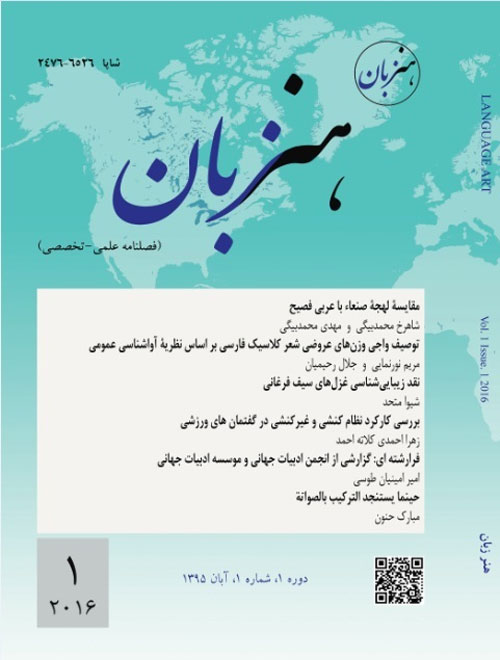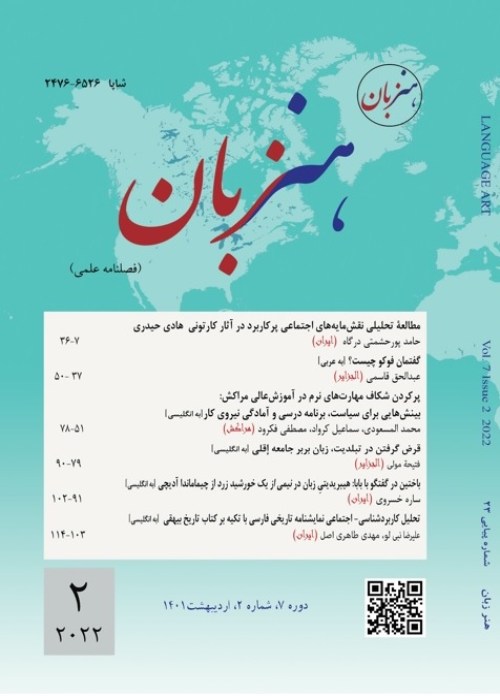فهرست مطالب

نشریه هنر زبان
سال یکم شماره 1 (آبان 1395)
- تاریخ انتشار: 1395/09/20
- تعداد عناوین: 6
-
صفحات 5-19هدف از نگارش این مقاله، شناسایی برخی از خصوصیات آوایی لهجه صنعاء و مقایسه آن با زبان عربی معیار است. لهجه صنعاء یا لهجه صنعانیه درواقع لهجه مردمان صنعاء پایتخت یمن است. این لهجه بهواسطه غلبه معمول لهجه پایتخت بر دیگر لهجه های یمن شاید بهعنوان لهجه یمنی نیز شناخته شود. داده ها از طریق مصاحبه حضوری غیررسمی با دانشجویان یمنی به صورت فردی یا جمعی و مکالمه با افراد بومی در شهر صنعاء به عنوان سخنگوهای آن لهجه و همچنین مشاهده و شنیدن سخن آن ها و تجزیه و تحلیل کلامشان و با تکیه بر دیگر روش های تحقیقات میدانی گردآوری شده است. و در این مقاله تمرکز نویسندگان معطوف به بیان تغییرات آوایی در ضمایر و دستگاه های فعلی این لهجه است.کلیدواژگان: زبان عربی، لهجه صنعاء، صنعانیه، صرف، نحو
-
صفحات 21-36هدف از توصیف واجی وزن های عروضی شعر کلاسیک فارسی 1. بهره مندی از چهارچوب نظری آواشناسی عمومی در توصیف وزن های عروضی؛ 2. نشاندادن تفاوت های واجی شعر عروضی با زبان فارسی معیار و 3. بررسی تغییرات واجها و الگوهای هجایی در شعر فارسی قبل و بعد از اعمال وزنهای عروضی بر برش هجایی آنها بوده است. بدینمنظور، تعدادی از ابیات اشعار عروضی بهطورتصادفی انتخاب شدند و برش هجایی آنها قبل و بعد از اعمال وزنهای عروضی نشان داده شد. درنهایت، بر اساس ساختمان الگوهای هجایی زبان فارسی، تفاوتهای بارزی در الگوهای هجایی وزنهای عروضی شعر فارسی مشاهده شد: 1. تعداد کمیتهای عروضی از نظر نوع وزن از کمیتهای هجایی زبان فارسی معیار کمتر است. 2. رفتار همخوانها و واکه ها در اشعار عروضی با رفتار آنها در زبان فارسی معیار تفاوت چشمگیری دارد؛ هم خوانها به تنهایی میتوانند معرف یک کمیت عروضی باشند و کشش هیچیک از واکه های زبان فارسی در بافت عروضی شعر ثابت نیست.کلیدواژگان: کمیت های عروضی، موراهای زبان فارسی، واکه های شعر عروضی
-
صفحات 37-58زیبایی شناسی سخن پارسی تحلیل شعر فارسی از دیدگاه بدیعی و بیانی و بهطورکلی از دیدگاه بلاغی است؛ آنگاه که به تحلیل شعر از دیدگاه بیانی می پردازیم ، تشبیه ها، استعاره ها، کنایه ها، مجازها و نمادهای آن را باز می نماییم یا هنگامی که از زاویه دانش معانی از غرض ثانوی سخن شاعرانه سخن می گوییم یا حتی وزن عروضی بیتی را باز می نماییم ، همه تحلیل های زیباییشناختی سخن پارسی است.
سیف فرغانی از شاعران برجسته فارسی است که قرارگرفتنش در کنار سعدی در یک قرن، و همچنین به دلیل مهاجرتش به منطقه آسیای صغیر باوجود لطافت طبع و غزل های بسیار دلنشینش آن طور که باید شناخته نشده است؛ این پژوهش سعی دارد زیبایی های کلام سیف فرغانی را بشناساند؛ از اینرو، پژوهش حاضر به زیبایی شناسی ساختاری در اشعار سیف فرغانی می پردازد و صنایع بدیعی و آرایه های ادبی و هم چنین ظرافت های زبانی غزل های سیف فرغانی را شرح داده، به تاثیرپذیری های این شاعر لطیف طبع قرن هفتم هجری، از سعدی استاد بزرگ سخن نیز می پردازد.کلیدواژگان: سیف فرغانی، زیباییشناسی، غزل، نقد، شعر، آرایه -
صفحات 59-80این مقاله به تحلیل کلامی نمونه هایی از متنهای ورزشی روزنامه های ایران میپردازد و به نظام کنشی (روایی) و غیرکنشی (عاطفی و شناختی و تنشی) در رویکرد نشانهمعناشناختی نوین در تحلیل متن توجه میکند. هدف مقاله حاضر بررسی شرایط تولید معنا از نظر سازوکارهای کنشی و غیرکنشی در گفتمانهای ورزشی است. بر همین اساس، مشاهده می شود که معنا و فرایند تولید آن در همه گفتمانها دارای سازوکارهای یکسان نیستند. در گفتمان (ورزشی)، معنا میتواند از ویژگی های نظام روایی، عاطفی، شناختی و تنشی تبعیت کند.
با بررسی کارکرد نظام کنشی و غیرکنشی در گفتمان ورزشی و براساس متنهای منتخب از مطبوعات ورزشی، بسامد کارکرد هر یک از نظامهای گفتمانی مشخص شده است. گفتمان ورزشی همانند دیگر گفتمانها از تعامل نظام گفتمانی متنوعتری بهره مند است تا بتواند وقایع و رویدادهای ورزشی را بهخوبی بازگو نماید؛ اما براساس تحلیلهای انجامشده درباره متنهای ورزشی در مقاله حاضر، این نتیجه حاصل می شود که نظام کنشی بیش از نظام غیرکنشی زیربنای متنهای ورزشی را تشکیل میدهد.کلیدواژگان: گفتمان، نشانهشناسی، نشانه، معناشناسی کنشی (روایی)، نشانه، معناشناسی غیرکنشی (عاطفی و شناختی و تنشی) -
صفحات 81-102مقاله پیش رو تلاشی جهت پوشش دادن همایشها و بحثهایی که جهت بازتعریف مفهوم ادبیات نه تنها در حوزهای که همگی با آن آشنایی داریم، بلکه در مفهومی گسترده تر و جهانی است. درواقع، این مقاله در پی یافتن معانی و روابط پیچیده ادبیات در جوامع مختلف، فرهنگهای مختلف و پیداکردن اشتراک ها و خطوط یکسان در آنها است. ادبیات در جایگاهی بسیار وسیع که قابلیت تاثیرگذاری بر سیاست، اقتصاد و اجتماع را دارد، دارای نقشی کاربردی و فراتر از بینامتنی است.
گزارش حاضر با موردمثالقراردادن چندین همایش و مطرحکردن عناوین اصلی و اهداف آنها سعی بر یافتن خط مشی مشخص جهت واکاوی ادبیات حال حاضر جهان و آینده آن دارد.کلیدواژگان: انجمن، ادبیات، جهانی شدن، سمینار، فرارشته ای -
صفحات 103-122یرمی هذا البحث إلی البرهنه علی ان الوقف، باعتباره ظاهره إیقاعیه (صوتیه)، لیس تابعا للترکیب ولا اثرا من آثاره کما کانت قد ذهبت إلی ذلک الصواته التولیدیه. وقد اعتمد الباحث، للبرهنه علی استنجاد الترکیب بالوقف وإعاده تنظیم القول لیکون تاما ودالا، علی نصوص من القرآن الکریم، وعلی تراث لغوی ساهم فیه النحاه والمفسرون والاصولیون، من جهه، وعلی تراث لسانی طمسته النظریات التی هیمنت علی الساحه اللسانیه. وقد اکتفینا، هنا، بدراسه ظاهرتین: تتمثل اولاهما فی دور الوقف فی رفع اللبس الترکیبی، بینما تتمثل الثانیه فی تاسیس الوقف للعلاقات الترکیبیه. وقد تبنینا، لبیان ذلک، النظریه الصواتیه الإیقاعیه کما تبلورت داخل الاتجاه التولیدی.
وقد خلصنا إلی ان الوقف مبنین للقول، وموجه وبان له. وبذلک لا یکون الوقف ظاهره سطحیه بل هو ظاهره موسسه للقول مساویه، فی هذا الباب، للترکیب. وهکذا، تبطل فکره تحکمیه الترکیب، وتبرز فکره التعاون بین مکونات النحو (الصواتیه والصرفیه والترکیبیه والدلالیه والتداولیه) من اجل إنتاج اقوال تومن التواصل اللغوی وتصونه.کلیدواژگان: الوقف، علم الاصوات، اللبس الترکیبی، التعقید الترکیبی، المقولات الترکیبیه والصرفیه، التنغیم، التقطیع الزمنی
-
Pages 5-19The purpose of this paper is to identify some phonetic characteristics of Sanaani accent and to compare them with the Standard Arabic language. Sana''a dialect or accent Sanaaniye is the accent of Sanaa people¡ the capital city of Yemen. Perhaps by the influence of the accent of capital city on the other accents¡ this accent is known as Yamani accent¡ too. Data were collected through the methods of informal interviews by students of Sanaa university and other native people of Sanaa as Yemens spokespersons¡ and direct observation¡ collective discussions¡ analyses of personal documents produced within the group¡ self-analysis and other methods of field research. And in this article¡ authours focus is on the phonetic changes in pronouns and verbs in this accent.Keywords: Arabic Language, Accent of Sanaa, Sanaani, Morphology, Syntax
-
Pages 21-36The aim of phonemic description of prosodic meters of classical Persian poetry was applying the theoretical framework of General Phonetics in: 1. Describing the prosodic meters¡ 2. Indicating the phonemic differences between prosodic poetry and Standard Persian language¡ 3. Investigating the changes of phonemes and syllabic patterns before and after applying prosodic meters on their syllabic segmentations. Therefore¡ some verses with prosodic meters have been selected randomly¡ and their syllabic segmentations have been indicated before and after applying prosodic meters on them. Regarding the structures of the syllabic patterns of Persian language¡ the results indicated clear differences in the syllabic patterns of prosodic meters of Persian poetry. 1. The number of prosodic quantities is lower than that of Standard Persian language considering type of meter¡ 2. the behaviors of vowels and consonants in prosodic poetry differ from the behaviors of vowels and consonants in Standard Persian language extensively; consonants can be solely presented as a prosodic quantity¡ and none of the Persian vowels have a fixed length in the context of prosodic poetry.Keywords: Prosodic Quantities, Moras of Persian Language, the Vowels of Prosodic Poetry
-
Pages 37-58The aesthetics of Persian language is the analysis of poems'' figures of speech. When we are analyzing the diction of Persian poems¡ we find similes¡ metaphors¡ allusions¡ synecdoches and symbols or when we are speaking of the secondary objective of the poet or even we talk about the prosodic meter of a poetry; all are aesthetic analysis of Persian language.
Seyfe Farghani is one of the greatest poets in Persian language¡ but his coincide with the great¡ Saadi¡ and his immigration to Minor Asia¡ were the causes of his remaining unknown; he has been not known as he should be in spite of his wits and harmonious lyrics. Therefore¡ this research has analyzed the structural aesthetics of Seyfe Farghanis lyrics¡ figures of speech and sensibility. This article also indicate the influence of Saadi Shirazi on this witty poet in 7 A.H.Keywords: Seyfe Farghani, Aesthetics, Lyrics, Criticism, Poetry, Figure of Speech -
Pages 59-80This paper is concerned with discourse analysis about samples of sport texts in Iranian newspapers based on semiotics approach¡ its purpose is investigation about condition of meaning production according to narrative and non-narrative mechanisms in sport discourse. In this regard¡ it shows meaning and its process of production have mechanisms which arent equal in all discourses; and according to condition of discourse¡ can comply with features of narrative or non-narrative (tense-cognitive-emotive) systems.
According to the subject of the paper and the chosen sport texts¡ application frequency of each discourse system will be found in these texts. Although sport discourses the same as other discourses benefit from interaction of different types of discourse systems that show sport events well and get remarkable results¡ but they are more based on narrative system to non-narrative system.Keywords: Discourse, Semiotics, Semiotic Narrative, Semiotic Non, narrative -
Pages 81-102The current article is an attempt to cover conferences and discussions on redefining the meaning of literature¡ not only in its typical sense¡ but also in its broader sense. In fact¡ the text is trying to find the complicated meaning and relationships in literature in different societies¡ cultures¡ and aims to find similarities and common areas in this field. Literature in a sublime position is capable to influence on politics¡ economy and sociology¡ and it has a major and functional role other than intertextuality.
The present report exemplifies some conferences by outlining their most important goals and tries to find an obvious guideline to research in todays literature and its future.Keywords: Association, Literature, Globalization, Seminar, Interdisciplinar -
Pages 103-122The objective of this paper is to demonstrate that pause as a prosodic (phonological) phenomenon¡ is not dependent on syntax¡ nor is it one of the byproducts thereof¡ as claimed in generative phonology. In order to argue for the recourse of syntax to the pause and reorganization of speech to be complete and significant¡ the author draws on a language heritage provided by grammarians¡ interpretation specialists and purists¡ on the one hand¡ and a linguistic heritage undermined by the predominant theories in the linguistic landscape. The paper focuses on two phenomena: the role of pause in disambiguating syntactic chunks¡ and as a catalyst for establishing syntactic structures. Prosodic phonological theory has been adopted in this regard¡ as it has been developed within the generative paradigm.
The paper concludes that pause is a structuring and guiding component of speech. Hence¡ it is not a superficial phenomenon¡ rather a catalyst for establishing speech¡ on equal footing with syntax in this regard. The dominating status of syntax seems less valid¡ overshadowed by the synergy of the components of grammar (phonology¡ morphology¡ syntax¡ semantics and pragmatics) to produce speech chunks that ensure and preserve communication.Keywords: Pause, Phonology, Syntactic Ambiguity, Syntactic Complexity, Morphological, Syntactic Categories, Intonation, Timing


